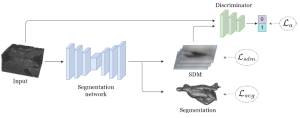Medical imaging plays a critical role in the diagnosis and treatment of various diseases and disorders. However, traditional medical imaging methods have limitations when it comes to accurately identifying and segmenting specific structures within an image. This is where shape-aware semi-supervised 3D semantic segmentation comes in, offering a powerful new tool for medical professionals to improve diagnostic accuracy and streamline treatments.
What is Shape-Aware Semi-Supervised 3D Semantic Segmentation?
Shape-aware semi-supervised 3D semantic segmentation is a machine learning technique that utilizes both shape and context information to accurately segment structures in 3D medical images. It allows for the identification and segmentation of specific structures within an image, such as organs, bones, and tumors, which can be used for diagnosis and treatment planning.
The “semi-supervised” aspect of this technique refers to the use of a small amount of labeled data to train the algorithm, with the remaining data being unlabeled. This allows for the algorithm to learn from a larger amount of data, improving its overall performance.

Advantages of Shape-Aware Semi-Supervised 3D Semantic Segmentation
There are several advantages to using shape-aware semi-supervised 3D semantic segmentation in medical imaging. Some of the key benefits include:
- Improved diagnostic accuracy: With the ability to accurately identify and segment specific structures within an image, shape-aware semi-supervised 3D semantic segmentation can lead to earlier and more accurate diagnoses.
- Streamlined treatment planning: By accurately identifying and segmenting specific structures, shape-aware semi-supervised 3D semantic segmentation can aid in the planning of treatments such as radiation therapy and surgery.
- Reduced human error: By automating the process of identifying and segmenting specific structures, shape-aware semi-supervised 3D semantic segmentation can help reduce human error and improve overall diagnostic accuracy.
- Handling of large datasets: With the ability to learn from a larger amount of unlabeled data, shape-aware semi-supervised 3D semantic segmentation can handle large datasets, making it a powerful tool for big data analysis in healthcare.
Challenges and Ethical Considerations
As with any new technology, there are challenges and ethical considerations to be taken into account when using shape-aware semi-supervised 3D semantic segmentation in medical imaging. Some of the key challenges include:
- Data privacy and security: With the handling of sensitive medical data, it is crucial to ensure that data privacy and security are maintained.
- Algorithm bias: It is important to ensure that the algorithm is not biased in its segmentation of specific structures.
- Human oversight: While the algorithm can automate the process of identifying and segmenting specific structures, it is important to have human oversight to ensure that the results are accurate and unbiased.
Conclusion
Shape-aware semi-supervised 3D semantic segmentation is a powerful tool for medical professionals, offering improved diagnostic accuracy and streamlined treatment planning. By utilizing both shape and context information, this technique can accurately identify and segment specific structures within 3D medical images. However, it is important to take into account the challenges and ethical considerations when implementing this technology. As the field of medical imaging continues to evolve, shape-aware semi-supervised 3D semantic segmentation has the potential to revolutionize the way we diagnose and treat diseases and disorders.
